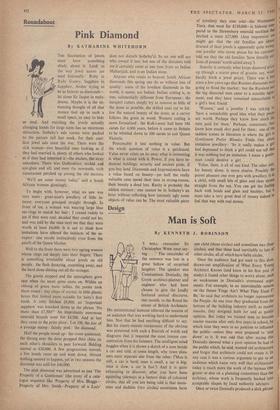Design
Man is Soft
By KENNETH J. ROBINSON
WELL remember Sir Christopher Wren once say- ing . .' The remainder of the sentence was lost in a great bellow of surprised laughter. The speaker was Constantinos Doxiadis, the Greek architect-planner and engineer who had been chosen to give the loudly fanfared annual discourse, this month, to the Royal In- stitute of British Architects. His unintentional humour relieved the tension of an audience that was working hard to understand him. Not that he had anything difficult to say. But his ninety-minute restatement of the obvious was presented with such a flourish of words and diagrams that it required the most intense con- centration from his listeners. The intelligent mind boggles when it is shown a sketch of a man beside a car and told, at some length, why town plan- ners must separate one from the other. (Wan is soft, a car is hard; man is small, a car is big; man is slow, a car is fast.') And it is quite exhausting to discover, after you have been squinting sideways at a lantern slide of coloured circles, that all you are being told is that mum- mies and daddies (two circles) sometimes have
one child (three circles) and sometimes two (four circles), and that these lead inevitably to lots of other circles, all of which have baby circles.
Once the audience had got used to this slog, drawn-out amplification of What Every young Architect Knows (and knew in his first year of study) it found other things to worry about, such as weaknesses in Doxiadis's overstated argil- ments. For example, in an interminable session on the theme 'Fings Ain't What They Used T. Be,' he said that architects no longer represented the People. At one time they graduated from the bottom of the building industry until, as master masons, they designed both for and as pubille opinion. But today we trained men to become master masons after only five years in school, bY which time they were in no position to influence the public—unless they were prepared to 'step down' to it. It was odd that after saying this Doxiadis showed what a poor opinion he had of the public which, he said, wanted old architecture and forgot that architects could not create it. In any case it was a curious argument to put to an audience which knew very well that architecture today is much more the work of the layman (the grocer or don on a planning committee) than the architect, whose work is frequently hacked into acceptable shapes by local authority advisers.
Once or twice Doxiadis produced a slick phrase
and momentarily concealed the fact that he was not saying anything new. 'We must conquer sPace,' he said. `by walking into space'—another wcaY of pointing out the value of pedestrian pre- cincts (long accepted by architects) in our towns. And he had a lot to say about the importance of the fourth dimension in architecture ('the ,,A.cropolis was left unfinished as a symbolism of me fourth dimension of time). But every architect and Planner knows that time, as Doxiadis said, ,rings increases in population and that these Mould be catered for by the design of buildings and neighbourhoods which can be added to. The remainder of Doxiadis's discourse can be dsumrned p
u in a few sentences. We need lugh-
,ensitY buildings, pedestrian areas' and architec- ture that repeats itself (this was usefully illustrated with a slide of a dragonfly's wing) with- out avoiding the best in traditional or universal ideas. And in creating all these the architect must collaborate with engineers, sociologists and town planners to give buildings a human scale. One more thing. And this was the only original thought in the discourse. Our cities must expand on the theory of `Dynapolis.' Instead of destroy- ing the old and building again we must shuffle off sideways, with each new generation, and create a new city core a few miles away, until eventually we shall have a whole line of city centres, each with a larger neighbourhood than the one before. This, as an LCC planner remarked afterwards, is fine if you are starting from scratch; but if you tried to do it in south-east England you would create a never-ending nightmare.



















































 Previous page
Previous page